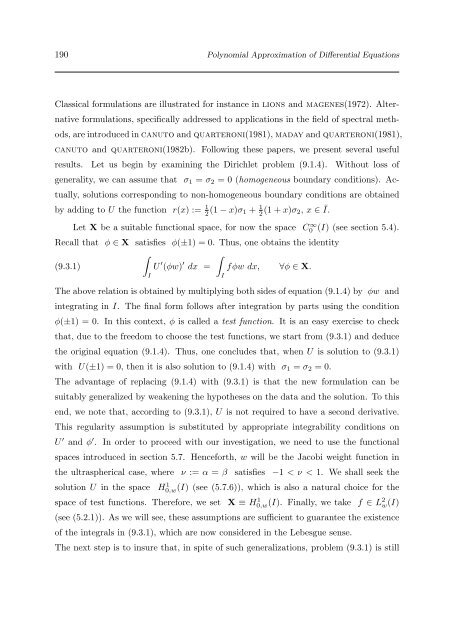Untitled - Cdm.unimo.it
Untitled - Cdm.unimo.it
Untitled - Cdm.unimo.it
You also want an ePaper? Increase the reach of your titles
YUMPU automatically turns print PDFs into web optimized ePapers that Google loves.
190 Polynomial Approximation of Differential Equations<br />
Classical formulations are illustrated for instance in lions and magenes(1972). Alter-<br />
native formulations, specifically addressed to applications in the field of spectral meth-<br />
ods, are introduced in canuto and quarteroni(1981), maday and quarteroni(1981),<br />
canuto and quarteroni(1982b). Following these papers, we present several useful<br />
results. Let us begin by examining the Dirichlet problem (9.1.4). W<strong>it</strong>hout loss of<br />
general<strong>it</strong>y, we can assume that σ1 = σ2 = 0 (homogeneous boundary cond<strong>it</strong>ions). Ac-<br />
tually, solutions corresponding to non-homogeneous boundary cond<strong>it</strong>ions are obtained<br />
by adding to U the function r(x) := 1<br />
2 (1 − x)σ1 + 1<br />
2 (1 + x)σ2, x ∈ Ī.<br />
Let X be a su<strong>it</strong>able functional space, for now the space C ∞ 0 (I) (see section 5.4).<br />
Recall that φ ∈ X satisfies φ(±1) = 0. Thus, one obtains the ident<strong>it</strong>y<br />
<br />
(9.3.1)<br />
U ′ (φw) ′ <br />
dx = fφw dx, ∀φ ∈ X.<br />
I<br />
I<br />
The above relation is obtained by multiplying both sides of equation (9.1.4) by φw and<br />
integrating in I. The final form follows after integration by parts using the cond<strong>it</strong>ion<br />
φ(±1) = 0. In this context, φ is called a test function. It is an easy exercise to check<br />
that, due to the freedom to choose the test functions, we start from (9.3.1) and deduce<br />
the original equation (9.1.4). Thus, one concludes that, when U is solution to (9.3.1)<br />
w<strong>it</strong>h U(±1) = 0, then <strong>it</strong> is also solution to (9.1.4) w<strong>it</strong>h σ1 = σ2 = 0.<br />
The advantage of replacing (9.1.4) w<strong>it</strong>h (9.3.1) is that the new formulation can be<br />
su<strong>it</strong>ably generalized by weakening the hypotheses on the data and the solution. To this<br />
end, we note that, according to (9.3.1), U is not required to have a second derivative.<br />
This regular<strong>it</strong>y assumption is subst<strong>it</strong>uted by appropriate integrabil<strong>it</strong>y cond<strong>it</strong>ions on<br />
U ′ and φ ′ . In order to proceed w<strong>it</strong>h our investigation, we need to use the functional<br />
spaces introduced in section 5.7. Henceforth, w will be the Jacobi weight function in<br />
the ultraspherical case, where ν := α = β satisfies −1 < ν < 1. We shall seek the<br />
solution U in the space H 1 0,w(I) (see (5.7.6)), which is also a natural choice for the<br />
space of test functions. Therefore, we set X ≡ H 1 0,w(I). Finally, we take f ∈ L 2 w(I)<br />
(see (5.2.1)). As we will see, these assumptions are sufficient to guarantee the existence<br />
of the integrals in (9.3.1), which are now considered in the Lebesgue sense.<br />
The next step is to insure that, in sp<strong>it</strong>e of such generalizations, problem (9.3.1) is still
















